C3 CHURCH TIMELINE
1952 (May 21): Phil Pringle was born in Masterton, New Zealand.
1971: Phil had a vision of the devil circling him. Frightened, he called out, “Jesus!”
1971: Phil and then-girlfriend Christine (known as a “Chris” within the movement) responded to an altar call at an Assembly of God Church in Sydenham, a suburb outside of Christchurch. They were born again.
1971 (August 8): Phil and Chris were married.
1972: While living in Oxford Terrace, New Zealand, a pastor from Sydney, Paul Collins, attended one of Phil and Chris’s house meetings. He made the comment, “Oh, we need something like this in Sydney,” thereby planting the seed of Phil’s vision that he would one day start a church in Sydney.
1973: Pastor Dennis Barton was ousted from the Sydenham Assembly of God Church. Phil and Chris followed him to his new church in Christchurch, where they become Youth Leaders.
1978: Phil received an invitation to preach in Madras, India. On his route back to New Zealand from South Asia, his plane landed in Sydney. He then heard a voice (which he interpreted as the voice of God) saying, “I want you to come to Sydney.”
1979: In Lyttleton, New Zealand, Phil envisaged starting a church in Sydney that had an associated Arts and Bible College.
1980: Phil and Chris moved from Lyttleton to Sydney to start Christian Centre Northside Church.
1980: The church hosted its first service (an Easter Service) at Dee Why Surf Club in Oxford Falls. Only twelve people attended.
1984: Oxford Falls Grammar School and C3 College were established.
2008: At the “Here We Go” global conference held in Hawaii, Christian City Church announced that it would officially change its name to “C3 Church.”
2020: C3 Church oversees 594 churches in sixty-four countries, and a global membership of more than 100,000.
FOUNDER/GROUP HISTORY
Phil Pringle was born on May 21, 1952 in Masterton, New Zealand to an upper-middle class family. When he was very young his mother passed away from brain cancer. Christine Pringle (known as “Chris” within the C3 movement) came from a lower-class background, and her father died when she was only an infant. The two first met as young kids growing up in Masterton, but it wasn’t until they both attended Wairarapa College, where they took the same English and History classes, that they became friends, and eventually, high school sweethearts. The two connected over their shared passion for art, music, and drama (Shin 2014). After high school Phil began working as a garbage-collector and attending Arts School, while Chris studied to become a Kindergarten teacher.
Coming of age in the 1960s, the couple were heavily involved in the New Zealand hippie movement; in their teens they grew their hair long, experimented with psychedelics, and studied Eastern philosophy and religion. According to Chris, at the time, “the only people we knew were clairvoyants or card readers” (Shin 2014). In 1971, while living together in Christchurch, Phil had a vision of the devil while in a semi-conscious state. In a panic, he woke up and cried out, “Jesus!” Deeply frightened, the couple said the Lord’s Prayer together. The next morning, they phoned a friend of theirs, Dorothy, for advice. Dorothy, who read tarot cards, recommended they visit a psychic society. However, Dorothy’s mother, May, who had just converted to Christianity three weeks earlier, overheard the conversation. May got the couple’s number from Dorothy and phoned them back, putting them in touch with an Assembly of God (Pentecostal) church. The following Sunday, Phil and Chris 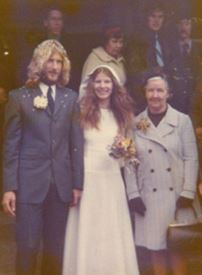 visited the church, which was located in Sydenham, a suburb outside of Christchurch, and led by a pastor named Dennis Barton. At the end of the service, the pastor invited all of the congregants to receive Jesus Christ. Both Phil and Chris walked to the front and were born again. Three weeks later, at the request of the church, the couple got married (Barclay 1987). [Image at right]
visited the church, which was located in Sydenham, a suburb outside of Christchurch, and led by a pastor named Dennis Barton. At the end of the service, the pastor invited all of the congregants to receive Jesus Christ. Both Phil and Chris walked to the front and were born again. Three weeks later, at the request of the church, the couple got married (Barclay 1987). [Image at right]
Under the direction of pastor Dennis Barton, Phil and Chris became Youth Leaders at the church. They also moved into a large house with other church members, holding prayer meetings on Monday nights that attracted between seventy to one hundred people. In 1972, a pastor from Sydney, Australia, Paul Collins, attended one of their house meetings. He made the comment, “Oh, we need something like this in Sydney.” Phil recalls this event as the moment God gave him the vision that he would one day lead a church in Sydney (Barclay 1987).
In 1973, pastor Dennis Barton was asked to step down as pastor and leave the church. This caused massive rifts within the congregation. Phil and Chris struggled with the decision over whether or not to leave. In the end, they followed Barton and helped him plant a new church in Christchurch (Barclay 1987).
Sometime after serving as an associate pastor with Barton in Christchurch, Phil felt a strong call to start a church in Sydney. He received an offer from pastor Paul Collins to serve with him at his congregation in Sydney. Phil convinced Chris to make the trip, confident that his vision would soon come to fruition. However, after only five months in Sydney, it became clear that this was not the right time. Having found little success in their new venture, the couple were forced to return to Christchurch. Phil fell into a deep depression. He decided to quite the ministry for good, and he took up a job as a postman (Pringle 2005:71).
While working as a postman, Phil’s desire to become a pastor gradually returned. He and Chris made the decision to move to Lyttleton, a suburb outside of Christchurch, to start their own church. They ran this church for three years. During this period, Phil allegedly received signs from God that he would one day plant a church in Sydney, as well as found a Christian College. In 1978, Phil received an invitation to preach at a crusade in Madras, India. On his return trip back to New Zealand, his plane stopped in Sydney. Upon landing, Phil heard what he interpreted as the voice of God say, “I want you to come to Sydney” (Barclay 1987).
Later that year, Phil and Chris put a deposit down on a home in Lyttleton. However, soon after placing the deposit, Phil regretted the decision, feeling strongly that he and Chris needed to make the trip to Sydney to plant a church. He convinced her to forfeit the deposit, and in 1980 they made the move to Sydney with their three children, Daniel, Rebekah, and Joseph. They were followed by Simon and Helen McIntyre, Alison Easterbrook, and Phil’s brother.
In 1980, Phil and Chris started Christian Centre Northside Church, which they took over from Paul Collins, who had moved to Hong Kong to do mission work. Their first service, an Easter Service, was held at the Dee Why Surf Club in Oxford Falls and had only twelve people in attendance. However, within four years, their church grew to four hundred members.
Throughout the 1980s, Phil spearheaded a number of church plants, first around Sydney, and then into other parts of Australia. Over this period, they renamed the church, “Christian C ity Church.” In 1984, Phil founded the Oxford Falls Grammar School as well as Christian City Church (now C3) College. In 2008, at the “Here We Go” global conference held in Hawaii, the church officially changed its name to “C3 Church.”
ity Church.” In 1984, Phil founded the Oxford Falls Grammar School as well as Christian City Church (now C3) College. In 2008, at the “Here We Go” global conference held in Hawaii, the church officially changed its name to “C3 Church.”
C3 Church has come a long way from its humble beginnings. While Oxford Falls still houses the church’s primary campus, C3 SYD Oxford Falls (which includes an arts and bible college, a grammar school, television studio, café, art gallery, and auditorium), one can find C3 Churches around the globe (on every continent except Antarctica). [Image at right] As of 2020, C3 Church Global boasts more than 500 churches in sixty-four countries (C3 Church Global 2020a).
Much of the success of the C3 movement is the result of Phil Pringle’s leadership skills and relentless entrepreneurialism. Since the movement’s beginnings, he has doggedly sought to expand the reach of C3 to the four corners of the earth, which he has accomplished by means of energetic preaching, impressive charisma, stoking intense missionary zeal, and harnessing the most up-to-date mass media technologies and marketing methods. Phil has long been a sought-after public speaker, both in religious and secular (business) contexts, speaking on topics as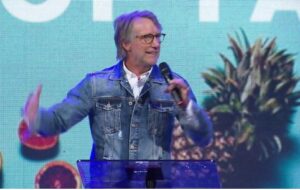 diverse as Christian faith, leadership, personal finances, and church planting. He regularly travels around the world to speak at conferences, [Image at right] preaching a combination of neo-Pentecostal and prosperity theology, which is highly tailored to appeal to contemporary late modern (and secular) sensibilities.
diverse as Christian faith, leadership, personal finances, and church planting. He regularly travels around the world to speak at conferences, [Image at right] preaching a combination of neo-Pentecostal and prosperity theology, which is highly tailored to appeal to contemporary late modern (and secular) sensibilities.
In many respects, Phil’s message resembles a kind of Christianized self-help, focused on empowering individuals to become prosperous leaders. However, his counter-cultural and artistic backgrounds also shape his teachings. For example, he places a sizeable emphasis in his talks on the themes of creativity, personal authenticity, and self-realization. Phil also hosts a television program, “Your Best Life with Phil Program,” which has appeared on ACC in Australia and TBN in Europe, and is today broadcast on YouTube. And in addition to speaking publicly, Phil has penned over seventeen books, which include: Moving in the Spirit (1994), Keys to Financial Excellence (2003), Faith: Moving the Heart and Hand of God (2005), Parable of the Dog (2014), and Leadership 101 (2018). Though none of his books have become international best-sellers they have nevertheless served to give substance and form to an overarching “C3 Culture.”
Chris Pringle has also played a significant role in spreading the reach of C3 Church. In the 1980s and 1990s, she was a singer in a Christian rock group. As co-leader of the movement, she regularly preaches at C3 conferences and events, and has from the start served as Senior Minister at the main church campus in Oxford Falls. And since 1998, Chris has led the Everywoman Gathering, an annual women-only C3 conference meant to empower and strengthen C3’s female community. In 2005, she published Jesse: Found In Heaven, which recounts her experience suffering a miscarriage, and how she grieved her unborn child.
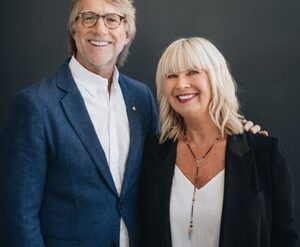
As of this writing, Phil is the President of C3 Church Global, the President of the Oxford Falls Grammar School Board, and the President of C3 College. Moreover, Phil and Chris are presently the Senior Ministers of all of the C3 Churches in Sydney [Image at right] (though in November 2021 they plan to step down and become Pastor Emeritus (C3 Church Sydney 2020). Thus, while C3 Church may be an international movement, encompassing hundreds of churches around the world, Phil and Chris’s personal imprint are never difficult to detect.
DOCTRINES/BELIEFS
As of November 2020, the C3 Church Global website lists the Church’s core beliefs as follows:
There is one God: God the Father, God the Son, and God the Holy Spirit.
In the deity of our Lord Jesus Christ the Son of God; we believe in His virgin birth, in His sinless life, in His miracles, in His victorious and atoning death, in His bodily resurrection, in His ascension to the right hand of the Father, His constant intercession and in His imminent return.
In the person and work of the Holy Spirit with His fruits and gifts available in the Church.
The Bible is the living word of God. It is infallible, authoritative and everlasting and is the foundation of all Christian doctrine.
In the existence of an evil spiritual being known as the devil.
In the spiritually lost condition of all people and the essential need for the new birth by faith in Jesus Christ.
In the baptism of the Holy Spirit as a gift available to believers subsequent to the new birth, with normal evidence of speaking in other tongues
In the sacraments of the Lords Supper and baptism by full immersion in water for all believers.
In the resurrection of both the saved and the lost, the one to everlasting life and the other to everlasting separation from God.
In the church being the body of Christ, and each member being an active part of a local church, fulfilling the Great Commission.
Marriage was instituted by God, ratified by Jesus, and is exclusively between a man and a woman. It is a picture of Christ and his church.
Sex is a gift from God for procreation and unity, and it is only appropriate within and designed for marriage. (C3 Church Global 2020b)
As this statement of beliefs makes clear, C3 Church falls squarely within the conservative evangelical camp inasmuch as it subscribes to traditional positions on doctrines, such as the virgin birth of Jesus Christ, the reality of miracles as reported in Scripture, and the imminent return of Christ. And in addition to theological conservatism, C3 Church likewise espouses social conservatism, viewing marriage as the exclusive remit  of heterosexual couples, and same-sex sexual relations as sinful. However, C3 Church also clearly belongs to the “Pentecostal” family, stressing as Phil and Chris do, [Image at right] baptism in the Holy Spirit, glossolalia (speaking in tongues), the existence of spiritual warfare, and the promise of divine healing.
of heterosexual couples, and same-sex sexual relations as sinful. However, C3 Church also clearly belongs to the “Pentecostal” family, stressing as Phil and Chris do, [Image at right] baptism in the Holy Spirit, glossolalia (speaking in tongues), the existence of spiritual warfare, and the promise of divine healing.
The Pentecostal aspects of Phil and Chris’s version of Christianity can be traced back to their conversion in an Assembly of God Church in Sydenham. However, it’s clear that, if the couple did ever subscribe to classical Pentecostalism (and this is doubtful), over the years they have increasingly deviated from it (for instance, C3 Church does not belong to the wider Pentecostal church network in Australia, the Australian Christian Churches (ACC)). In fact, C3 theology is best thought of as a synthesis of Pentecostal or Charismatic Christian motifs and ideas with the prosperity gospel.
The prosperity gospel has its principal roots in the nineteenth century religious movements, New Thought (sometimes called “mind-cure) and Christian Science, which, in one form or another, espoused a high anthropology, conceived of the inner self as itself divine, and championed a universal right to prosperity and physical healing (Coleman 2000: 47). Having said that said, twentieth-century prosperity preachers liberally blended these metaphysical religious traditions with secular modes of thought such as positive thinking, self-help, and positive psychology, a trend that is becoming increasingly common (Coleman 2000:127). In any case, the prosperity gospel stands firmly within the American tradition of rugged individualism and self-reliance.

According to historian Kate Bowler (2013) the prosperity gospel centres on four themes: faith, wealth, health, and victory (2013:7). Each of these themes is prominent in C3 theology. For instance, in Faith: Moving the Heart and Hand of God, [Image at right] Phil Pringle (2005) writes, “Faith is a time rebel. It travels through time into the future; it feels the experience of a yet future event. But it feels that event in the ‘now.’ Faith is not pretending that it’s there. It is not hoping that it’s there. It is not imagining that it’s there. Faith knows it’s there because it has the substance of the experience, or the thing, in itself. Faith is the substance of a ‘thing’; it feels the ‘thing’ existing within the heart right now. Because it exists inside me, I know that it exists” (2005:66).
What Phil is championing here is a form of “positive confession,” which refers to the idea that “words spoken ‘in faith’ are regarded as objectifications of reality” (Coleman 2000: 28). According to C3 theology, real faith is not passive but active, capable of manifesting things in the external world. Interestingly, in this way, C3’s prosperity message has striking resemblances to New Age Spirituality (Watts 2019).
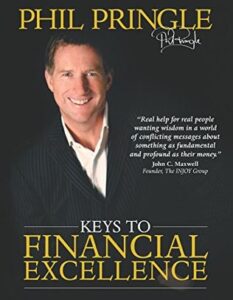
Furthermore, the accumulation of wealth plays a pivotal role in C3 teachings. Not only are C3 members encouraged to become affluent, but wealth is generally considered a sign of divine blessing. In Keys to Financial Excellence [Image at right] Phil Pringle (2003) writes, “Those who spend copious amounts of time embracing the tenets and teachings of Scripture are going to inherit the same spirit and principles of success and abundance that accompanied the lives of the wealthy and accomplished men who wrote it” (2003:45). He adds, “the Lord wants to give us an overflowing abundance!” (2003:50). Of course, if God wants all faithful Christians to be rich, then it stands to reason that if someone is poor it is because they lack faith. And indeed, this idea is intimated, if not outright endorsed, in Phil’s writings (see for example, Pringle 2005:186) (see picture of book cover).
And as for the themes of health and victory, it is a basic tenet of C3 theology that to become prosperous is not only to be financially well-off, but also to have good health and a positive self-image. According to Phil (2005), “A poor self-image is not just a minor handicap in life. It is not just some extra baggage that is unpleasant to carry around. It is a serious problem for our lives in God.” Accordingly, he counsels changing our “self-loathing” into “self-love” (2005:151). Moreover, Phil Pringle’s conception of spiritual warfare is couched almost entirely in therapeutic terms: “The Devil is the one who wants to keep you feeling unworthy and undeserving” (2005:154). Thus, within C3 thought, a mentality of victory (which entails feeling good about oneself, having self-confidence, and being upbeat) is idealized, while a victim mentality is tacitly pathologized. Phil sums this up, “Faith is an attitude of victory within” (Pringle 2005:32).
While C3 Church may fall within the conservative Protestant camp in terms of its stated beliefs, it is quite evident that in terms of both style and substance, it has eagerly embraced the counter-cultural and therapeutic ethos of the 1960s. Anthropologist Simon Coleman (2000) refers to this as the “‘Californication’ of conservative Protestants,” which refers to the way certain religious conservatives “have accommodated to the anti-institutional, therapeutic, cultural preferences of the baby boomers” (2000:24). One stark example of this accommodation shows up in the ways Phil and Chris regularly proclaim that C3 is “not a religion,” so much as a “faith,” a rhetorical strategy which mirrors the claim to being “spiritual but not religious” that has become commonplace in late modern societies (Watts 2020). Indeed, it is in large part owing to the church’s accommodation to the expressive individualism that defines mainstream Western culture in the twenty-first century that C3 Church has been uniquely successful in attracting young “hipsters” who see the church as an innovative and rebellious way to “do church” (Watts 2020b).
RITUALS/PRACTICES
While not all C3 churches can be considered megachurches proper (those with over two-thousand regular attendees), even the C3 campuses which have smaller congregations seek to recreate the aesthetic, style, and feel of the Oxford Falls campus. The reason for this is that C3 worship services have proven extremely effective at enabling the church to attract and convert members.

A critical factor in their success is the role of worship music. C3 Church has long marshalled the use of the most innovative sound equipment and performance technologies in order to give their Sunday services the feel of a contemporary rock concert [Image at right].
Moreover, at every C3 service one generally finds attractive young people (singers and instrumentalists) performing songs whose lyrics are projected on massive screens which hang at the back of the stage. They sing a combination of popular Christian worship music and music recorded and produced at C3 College. Indeed, the creation and dissemination of their original worship music has been pivotal to the church’s mission strategy (one can easily download C3 music on most streaming apps). However, the role of those onstage is not merely to perform for members in the audience, but also to “model the correct way to experience the presence of God” (Jennings 2008:163). Thus, from the moment one enters a C3 worship service, one is being trained in the art of “metakinesis,” a term which anthropologist Tanya Luhrmann (2004) uses to refer to the various ways individuals learn to identify and discern the presence of God in their subjective experiences (2004:522). It follows that the use of worship music in Sunday services plays a key role in creating a distinct auditory environment, which increases the likelihood that attendees will experience the presence of God (Wellman et al. 2014).
Another reason for C3’s success revolves around aesthetics. In order to attract newcomers, C3 church seeks to remove the potential barriers to cultural participation. So, instead of hymns, popular Christian music that closely resembles Top-40 radio is played; rather than taking place in old church buildings, services commonly take place in warehouses or  amphitheatres; and rather than traditional vestments, a dressed-down hipster dress code is tacitly normalized. Indeed, C3 churches tend to resemble other common sites of leisure in modern societies, such as the mall, the sports arena, or the movie theatre (Maddox 2012:153). [Image at right]
amphitheatres; and rather than traditional vestments, a dressed-down hipster dress code is tacitly normalized. Indeed, C3 churches tend to resemble other common sites of leisure in modern societies, such as the mall, the sports arena, or the movie theatre (Maddox 2012:153). [Image at right]
Of course, in keeping with their neo-Pentecostal background, C3 Church leaders do practice supernatural healing, full immersion baptisms, and speaking in tongues, however, these practices are often shielded from the general public. That is, they tend only to take place at exclusive C3 services and conferences, where media is generally prohibited. Thus, the church goes to great lengths not to alienate those whose cultural sensibilities might align with the mainstream in late modern societies.
Finally, in evangelical fashion, C3 members are regularly encouraged, while away from church, to read their bibles daily, participate in C3 activities and events, socialize with other Christians, and closely monitor their emotions and experiences for evidence of both God and the Devil. In this way, C3 theology asks of its members to stringently discipline themselves in conformity with its message of personal empowerment and material prosperity.
ORGANIZATION/LEADERSHIP
C3 Church Global, registered as a charity based out of Sydney, oversees the international church movement. C3 Church Global’s Board of Directors, headed by Phil Pringle, provides direction, vision, and goals for the movement at large. Under them sit the Regional Directors (all of whom are heterosexual married couples) who oversee the various C3 churches within a particular geographic region. These regions include Australia (with 106 churches), the Americas (with forty-six), Canada (with nineteen), East Africa (with eighty), Mena (with forty-six), East Asia (with three), Europe (with thirty-eight), South Asia (with eighty-four), South East 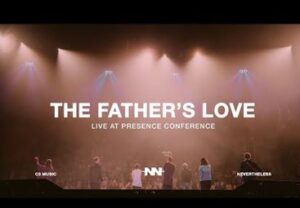 Asia (with seventy-five), Southern Africa (with twenty-six), West Africa (with nine), and Pacific (with fifty-five) (C3 Global 2020c). Within specific regions, Church Oversees are tasked with providing structure and support to local pastors. And each C3 Church is headed by Senior Pastors, who are sometimes supported by Junior Pastors.
Asia (with seventy-five), Southern Africa (with twenty-six), West Africa (with nine), and Pacific (with fifty-five) (C3 Global 2020c). Within specific regions, Church Oversees are tasked with providing structure and support to local pastors. And each C3 Church is headed by Senior Pastors, who are sometimes supported by Junior Pastors.
The overall coherence and consistency of the Church Movement is maintained through annual events and conferences, which draw C3 leadership and members from around the globe. The largest of these is the annual “Presence Conference,” [Image at right] held in a different location each year, which offers an opportunity for local C3 groups to hear their Senior Pastors preach in person, as well as an opportunity for leadership to announce new goals and directions for the movement.
At the same time, C3 College in Oxford Falls has long functioned as an incubator for aspiring C3 pastors; many who now hold leadership positions completed a degree at the college. At C3 College, students can take  courses in biblical studies and theology, music, film, and media, both in person and online. [Image at right]
courses in biblical studies and theology, music, film, and media, both in person and online. [Image at right]
There is a strong focus on media communications and digital marketing within the movement. The church relies on the free labour of its creative-class members to produce and disseminate C3 Church publicity, and promote the “C3 brand” around the world. Indeed, consumers can purchase C3 merchandise and products online from the “C3 Store,” which now sells everything from apparel, to books, to digital courses on personal development, leadership, and a Masterclass on church planting. And in recent years, the church has even developed its own app, “C3 Church Global App,” which individuals can use to locate C3 Churches in their local cities and towns.
While C3 Church Global seems on the surface to be a highly decentralized operation, it nevertheless exhibits a striking degree of standardized features. Indeed, the church operates much like a transnational corporation inasmuch as it is led by entrepreneurial Senior Pastors who espouse a top-down management style and command “obedience to an organisational culture” (Maddox 2012:152). In this way, C3 Church squarely belongs to what J. B. Watson and Walter H. Scalen (2008) call “the church growth movement,” which they contend is defined by the following four principles: an emphasis on quantitative measures of success such as worship attendance and number of new converts; a focus on “contextualixation, that is, a church delivers its message within the context of the culture”; the application of modern marketing techniques; and the value of net-working with like-minded churches (2008:171).
Finally, given that C3 Church has risen to prominence during the very same years that the Welfare State in Australia has been steadily dismantled, a number of scholars argue that its success owes much to its elective affinities with neoliberal economic policies (Shanahan 2019).
ISSUES/CHALLENGES
Phil Pringle, and C3 Church more generally, have been widely criticized by other Christian leaders and groups for preaching a version of Christianity that they consider heretical, shallow, and corrupt. In fact, self-described  ex-C3 members have setup a Christian watchdog website, “C3 Church Watch,” meant to bring attention to what they see as the church’s unbiblical teachings and dissuade others from joining the C3 movement. [Image at right]
ex-C3 members have setup a Christian watchdog website, “C3 Church Watch,” meant to bring attention to what they see as the church’s unbiblical teachings and dissuade others from joining the C3 movement. [Image at right]
Additionally, C3 Church has been forced to weather a number of public scandals in recent years. In 2017, a C3 pastor, Nicholas Dimitris, was found guilty of participating in a “straw borrower” scheme to defraud local banks (Weaver 2015). In 2017, Mosaic Defredes, a C3 pastor was convicted of a major piracy racket (Dunn and Sutton 2017). And another C3 pastor, Anthony Shalala, was allegedly paid $300,000 as compensation to leave the church following claims of sexual misconduct (Passi 2019).
Lastly, in 2019, the Australian television news program, A Current Affair, ran an exposé of the church. Showcasing negative testimonies from ex C3-members, along with footage of C3 events and an impromptu interview with Phil Pringle, [Image at right] the program took a critical stance on the church’s theology, funding practices, approach to mental illness, and views of same-sex relations (Passi 2019).
church. Showcasing negative testimonies from ex C3-members, along with footage of C3 events and an impromptu interview with Phil Pringle, [Image at right] the program took a critical stance on the church’s theology, funding practices, approach to mental illness, and views of same-sex relations (Passi 2019).
In response to the allegations, the church publicly denied any wrongdoing, and claimed that with respect to the issue of same-sex relations, “our approach is to embrace everyone and care for them on the basis of our overriding belief that our God is full of love and compassion for everybody, regardless of their personal circumstance or sexual orientation” (C3 Church Sydney 2019). The seeming conflict between the church’s official stance on same-sex relations (as represented in their official statement of beliefs) and public statements like this has become a heated source of controversy, especially in those cultural contexts where same-sex relations are generally considered unproblematic and entirely normal. For instance, C3 Toronto in Canada has been publicly criticized by an ex-member for deceiving her as regards their position on the issue of homosexuality (Garrison 2019).
It would seem, in turn, that there exists a real tension at the core of the movement insofar as it seeks to retain a commitment to traditional theological and social positions, while simultaneously accommodating to the latest cultural fads, embracing the most up-to-date forms of technology, and taking a strongly world-affirming stance. However, whether or not this tension will have negative consequences for the movement itself, only time will tell.
IMAGES
Image #1: Photograph of Phil and Chris Pringle at their wedding.
Image #2: The C3 Church logo.
Image #3: Photograph of Phil Pringle preaching.
Image #4: Photograph of Senior Ministers Phil and Chris Pringle.
Image #5: Photograph of Phil Pringle praying over parishioner.
Image #6: Cover of Faith: Moving the Heart and Hand of God.
Image #7: Cover of Keys to Financial Excellence.
Image #8: Musical performance at a C3 church service.
Image #9: C3 church in Calgary, Canada.
Image #10: The Presence Conference.
Image #11: Students participating in a class at C3 College.
Image #12: C3 Church Watch welbsite.
Image #13: Impromptu media interview with Phil Pringle.
REFERENCES
Barclay, John. 1987. Arise! The Story of Christian City Church. Sydney: Covenant Publishing.
Bowler, Kate. 2013. Blessed: A History of the American Prosperity Gospel. New York: Oxford University Press.
C3 Church Global. 2020a. “Home Page.” Accessed from https://c3churchglobal.com on 27 November 2020.
C3 Church Global. 2020b. “What We Believe.” C3 Church Global website. Accessed from https://c3churchglobal.com/what-we-believe/ on 27 November 2020.
C3 Church Global. 2020c. “This Is Us.” C3 Church Global website. Accessed from https://issuu.com/c3churchglobal/docs/this_is_us_-_c3_global on 27 November 2020.
C3 Church Sydney. 2019. “Media Response To A Current Affair.” C3SYD, December 5. Accessed from https://c3syd.church/media-response/ on 27 November 2020.
Coleman, Simon. 2000. The Globalisation of Charismatic Christianity: Spreading the Gospel of Prosperity. Cambridge: Cambridge University Press.
Dunn, Matt, and Candace Sutton. 2017. “Pastor Mosaic and his ‘disciple’ Allison masterminded Australia’s biggest piracy racket worth $21m.” News.com.au, March 21. Accessed from https://www.news.com.au/technology/online/hacking/pastor-mosaic-and-his-disciple-allison-masterminded-australias-biggest-piracy-racket-worth-21m/news-story/2b80939ce4e53ff17f304e68d23857ce on 27 November 2020.
Garrison, Alyssa. 2019. “I Fell For a ‘Progressive’ Church, and It Was a Mistake.” Flare.com, December 10. Accessed from https://www.flare.com/identity/c3-church-anti-gay/ on 27 November 2020.
Jennings, Mark. 2008. “‘Won’t you break free?’ An ethnography of music and the divine-human encounter at an Australian Pentecostal Church.” Culture and Religion 9:161-74.
Luhrmann, Tanya M. 2004. “Metakinesis: How God Becomes Intimate in Contemporary U.S. Christianity.” American Anthropologist 106:518-28.
Maddox, Marion. 2012. “‘In the Goofy parking lot’: growth churches as a novel religious form of late capitalism.” Social Compass 59:146-58.
Passi, Sacha. 2019. “Scott Morrison linked to controversial ‘miracles for money’ church.” A Current Affair. Accessed from https://9now.nine.com.au/a-current-affair/c3-church-scott-morrison-link-to-scandal-former-pastor/6579a36b-5a9e-462d-bcd4-ccae869081d1 on 27 November 2020.
Pringle, Phil. 2005. Faith: Moving the Heart and the Hand of God. New Kensington, PA: Whitaker House.
Pringle, Phil. 2003. Keys to Financial Excellence. New Kensington, PA: Whitaker House.
Shanahan, Mairead. 2019. “‘An Unstoppable Force for Good’?: How Neoliberal Governance Facilitated the Growth of Australian Suburban-Based Pentecostal Megachurches.” Religions 10:1-16.
Shin, Yong Tung. 2014. “Interview With the ‘Blonde Nana’: How Mr And Mrs Pringle Met.” City News, March 14. Accessed from https://www.citynews.sg/2014/03/14/interview-with-the-blonde-nana-how-mr-and-mrs-pringle-met/ on 27 November 2020.
Watson., J.B., and Walter H. Scalen. 2008. “‘Dining with the Devil’: The Unique Secularization of American Evangelical Churches.” International Sociological Review 83: 171-80.
Watts, Galen. 2019. “Religion, Science, and Disenchantment.” Zygon 54:1022-35.
Watts, Galen. 2020a. The religion of the heart: ‘Spirituality’ in late modernity.” American Journal of Cultural Sociology. Accessed from https://doi.org/10.1057/s41290-020-00106-x.
Watts, Galen. 2020b. “A hipster evangelical church is taking Toronto by storm,” CBC, July 8. Accessed from https://www.cbc.ca/documentaries/cbc-docs-pov/a-hipster-evangelical-church-is-taking-toronto-by-storm-1.5619110 on 27 November.
Weave, Emily. 2015. “Seven Falls conspirators to be sentenced June 2” Blue Ridge Now.com, April 23. Accessed from https://www.blueridgenow.com/news/20150423/seven-falls-conspirators-to-be-sentenced-june-2 on 27 November 2020.
Wellman, James K., Katie E. Corcoran, and Kate Stockly-Meyerdirk. 2014. “‘God Is Like a Drug…’: Explaining Interaction Ritual Chains in American Megachurches” Sociological Forum 29:650-72.
Publication Date:
30 November 2020
